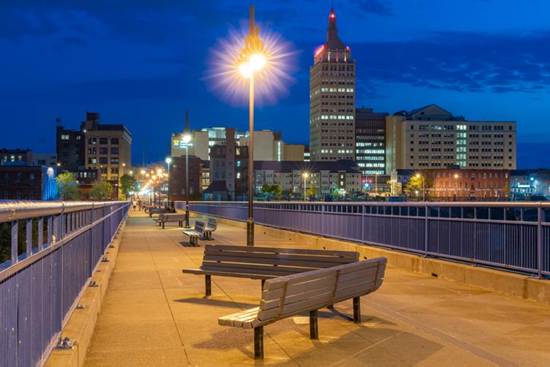
How Rochester’s Nightlife Impacts Accident Risks
Rochester’s nightlife is alive with character. Whether you’re sipping a craft beer in South Wedge, dancing on East Avenue, or catching a live set near the High Falls, there’s no shortage of places to unwind after dark. From the historic charm of Park Avenue cafes to the booming sound systems inside East End clubs, this city knows how to celebrate.
But as the music gets louder and the streets busier, risk climbs. Crowded sidewalks, tight turns, and late-night driving all come together to form a real concern: increased accidents after hours. This guide explores how Rochester’s thriving late-night culture can impact safety on the streets, and what can be done to protect drivers, cyclists, and pedestrians who want to enjoy it all without harm.

The Geography of Rochester’s Nightlife
Rochester’s late-night energy clusters in a few key neighborhoods. These areas shine with character, but they also create traffic patterns that can become dangerous after dark.
The East End, especially near Alexander Street, East Avenue, and Monroe Avenue, buzzes with activity most nights. You’ll find back-to-back bars, live music venues, and late-night eateries all packed into walkable blocks. A little to the west, the High Falls District draws concertgoers and event crowds around the Pont de Rennes Bridge and the Genesee Brewery area.
Because so many destinations are squeezed into a compact grid, there’s constant overlap between drivers, pedestrians, and cyclists. A single block might have five bars and three ride-share pickups. This density boosts nightlife appeal but raises the stakes when visibility drops and reaction times slow.
Peak Hours and Risk Windows
Ask any Rochester officer when the most incidents happen, and the answer is nearly always the same: between 10 p.m. and 3 a.m. Friday and Saturday nights are especially risky. Local crash data confirms that’s when emergency services see the biggest surge in calls.
The reasons are layered. First, you’ve got shift-change traffic — people leaving restaurants, hospitals, or bars all at once. Then there’s the last-call rush, when patrons hit the streets in waves. Add to that reduced bus service and limited transit options, and suddenly, many are walking or driving in less-than-ideal conditions.
- Weekend crash peaks: 11:30 p.m. to 2 a.m.
- Bar closings around 2 a.m. lead to curbside chaos
- Darker conditions worsen reaction time
Fatigue, distractions, and alcohol don’t just affect drivers. Pedestrians and cyclists also become slower to react, increasing the likelihood of collisions. An injury attorney in Rochester can fight for your rights if you’ve been injured in such a situation.
Alcohol and Impaired Driving
Alcohol plays a major role in nighttime accidents across Monroe County. In fact, it’s the leading contributing factor in fatal crashes after dark. New York law sets the legal blood alcohol concentration (BAC) limit at:
- 0.08% for Driving While Intoxicated (DWI)
- 0.05% for Driving While Ability Impaired (DWAI)
Local law enforcement takes these thresholds seriously. Rochester Police Department and Monroe County Sheriff’s Office often run DWI checkpoints, especially near nightlife zones. You might spot them along East Avenue or near the Inner Loop.
Programs like STOP-DWI Monroe County and Ride Safe ROC work to educate and intervene before impaired drivers hit the road. Still, the number of arrests after midnight continues to point to a stubborn trend: too many people still get behind the wheel when they shouldn’t.
Drug-Impaired and Polysubstance Driving
It’s not just alcohol anymore. Cannabis, prescription medications, and even over-the-counter drugs are showing up more often in traffic stops. With recreational marijuana now legal in New York, more drivers assume it’s safe to drive under its influence — but it’s not.
Cannabis slows reaction time, clouds judgment, and makes it harder to stay in a lane. Monroe County has expanded its Drug Recognition Expert (DRE) program to help officers detect non-alcohol impairment, but the road to full enforcement is still developing.
Mixing substances is especially dangerous. Someone who’s had a drink, smoked, and taken anxiety medication may feel “fine,” but their ability to drive can be worse than someone well over the legal alcohol limit.
Pedestrian and Cyclist Vulnerabilities at Night
Rochester’s nightlife neighborhoods weren’t built for perfect safety. Busy corners like East & Alexander or Monroe & Goodman become risky fast. A person stepping off the curb in dark clothing might not be visible until it’s too late.
In fact, about 40% of local pedestrian fatalities occur between dusk and dawn. Many happen within nightlife zones. Intersections around Chestnut and East Avenue are especially tricky — with limited crossing time, flashing signs, and high-volume turns.
Key safety reminders for pedestrians and cyclists:
- Use marked crosswalks and wait for signals
- Wear reflective gear or carry a light when biking
- Avoid crossing mid-block after leaving a venue
Rideshare, Parking, and Pickup Zone Congestion
Uber and Lyft make getting home easier. But curbside pickups create problems. Around midnight, the lines of cars on East Avenue or South Clinton often double-park. Riders rush to hop in, and drivers stop mid-block without warning.
These situations lead to:
- Rear-end crashes
- Sideswipes from fast-moving cars trying to pass
- Dangerous pedestrian crossings between cars
Designated pickup areas near bars or coordinated lot drop-offs could reduce this risk. Without those changes, traffic congestion will only get worse as nightlife grows.
Fatigue and Late-Night Commuters
Not all drivers out late are partygoers. Many are workers, bartenders, security staff, hospital employees, heading home after long shifts. Fatigue affects the brain much like alcohol, slowing reflexes and judgment.
After 11 p.m., crash data shows a clear bump in accidents tied to drowsy driving. These incidents often involve single-vehicle crashes, missed signals, or failure to yield. Drivers drift out of their lanes or fall asleep behind the wheel entirely.
Lighting, Infrastructure, and Road Design
Rochester has made improvements in lighting and signage through its Vision Zero Rochester initiative. Streets like East Main and State now have upgraded LED lights. Pedestrian islands and curb extensions have appeared in high-traffic zones to protect walkers.
Still, some alleys and side streets — especially near back parking lots — remain poorly lit. When nightlife spills out of venues into these darker areas, the chance of accidents grows. Consistent lighting across all nightlife corridors could make a huge difference.
Public Transportation and Late-Night Options
One big challenge? RTS (Rochester-Genesee Regional Transportation Authority) doesn’t offer full late-night service. That leaves people to walk, drive, or hope their rideshare shows up.
Expanding night routes or introducing micro-transit options would help. Some community groups now offer shuttle services or safe ride vouchers during large events, but these aren’t citywide solutions yet.
Event Nights and Traffic Spikes
Big events mean big crowds, and big risks. Festivals like the Lilac Festival, Fringe Festival, and Roc Holiday Village bring waves of foot and vehicle traffic downtown. Once the event ends, thousands try to leave at once.
The Rochester Police Department often sets up barricades and uses event-specific traffic control. Still, delays and confusion can lead to accidents, especially in poorly marked detour areas.
Planning ahead helps:
- Choose parking close to exits
- Arrange a ride before arrival
- Stay in groups when walking back to your car
Distracted Driving in Entertainment Districts
Bright lights, crowded streets, and GPS rerouting — it’s a recipe for distraction. Add in people checking texts or calling rideshares, and it’s no wonder downtown collisions spike at night.
Under VTL §1225-D, using a handheld device while driving is illegal in New York. But enforcement can’t catch everything. Many crashes near nightlife hubs are caused by drivers looking at their phones instead of the road.
Safety Measures for Nightlife Patrons
A little planning goes a long way:
- Don’t walk into the street while on your phone
- Wear light or reflective clothes if walking at night
- Use a designated driver or rideshare service
- Avoid isolated areas, especially when alone
- Park in well-lit, monitored lots
Small choices can protect you and everyone else on the road.
Law Enforcement and Community Partnerships
The Rochester Police Department works closely with local businesses to keep nightlife safe. Bar owners get safety briefings before large events. Patrols ramp up near closing time, and officers equipped with bodycams track high-risk times and areas.
Groups like MADD Western NY and STOP-DWI Monroe County also partner with the city, offering outreach and education in high schools and at public events.
Policy and Prevention Initiatives
Monroe County uses crash data to identify "nighttime high-injury networks.” These areas get prioritized for lighting improvements, speed enforcement, and safety campaigns.
Meanwhile, efforts to tighten alcohol service laws are ongoing. Servers at bars and clubs are being trained to recognize impairment and cut off service when necessary. Some venues now sponsor safe ride programs directly.
Economic and Cultural Balance
Nightlife isn’t just fun, it fuels Rochester’s economy. Events bring in visitors. Bars and venues create jobs. But the city is working to keep that growth aligned with public safety.
Efforts like wider sidewalks, better lighting, and reduced speed zones are meant to protect people, not limit enjoyment. The idea is simple: safety and celebration can — and should — go hand in hand.
Rochester thrives when people gather, celebrate, and connect. But safety is what keeps that energy sustainable. Whether you’re behind the wheel, crossing the street, or calling a ride, your choices matter.
Let’s protect what makes our nights memorable. Plan ahead. Stay sharp. Look out for one another.

What Sets Us Apart From The Rest?
Horn Wright, LLP is here to help you get the results you need with a team you can trust.
-
Client-Focused ApproachWe’re a client-centered, results-oriented firm. When you work with us, you can have confidence we’ll put your best interests at the forefront of your case – it’s that simple.
-
Creative & Innovative Solutions
No two cases are the same, and neither are their solutions. Our attorneys provide creative points of view to yield exemplary results.
-
Experienced Attorneys
We have a team of trusted and respected attorneys to ensure your case is matched with the best attorney possible.
-
Driven By Justice
The core of our legal practice is our commitment to obtaining justice for those who have been wronged and need a powerful voice.

